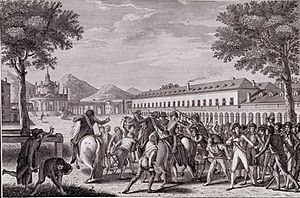Tumult of Aranjuez facts for kids
Quick facts for kids Mutiny of Aranjuez |
|||||||
|---|---|---|---|---|---|---|---|
| Part of the prelude to the Peninsular War | |||||||
 Fall and Imprisonment of the Prince of Peace, Manuel Godoy |
|||||||
|
|||||||
| Belligerents | |||||||
| Commanders and leaders | |||||||
| Manuel de Godoy |
|||||||
The Mutiny of Aranjuez (also known as the Tumult of Aranjuez) was a big uprising in Spain. It happened against King Charles IV in the town of Aranjuez. The mutiny took place from March 17 to 19, 1808.
This event is celebrated every year in the first week of September. It remembers when the King lost his power. It also celebrates his son, Ferdinand VII, becoming the new king. The celebration is in September because it was added to older festivals that already happened then.
The revolt was started by unhappy citizens. It was also supported by people who wanted Ferdinand to be king.
Contents
Why the Mutiny Happened
Before the mutiny, King Charles IV had a very powerful minister named Manuel de Godoy. Godoy was like the King's main advisor or prime minister. He used to be a simple guard, but he gained a lot of power. Many people, both nobles and regular citizens, did not like him.
Why Nobles Disliked Godoy
The rich nobles were upset because Godoy came from a poor family. They felt he did not deserve his high position. The King's own son, Ferdinand, was one of Godoy's biggest enemies. Ferdinand had even tried to remove Godoy from power a few months earlier.
Why People Disliked Godoy
Ordinary people were also unhappy with Godoy. They thought he was too ambitious. They also disliked that he made agreements with Revolutionary France. France was seen as having very different beliefs from Catholic Spain. These agreements were against Great Britain, which was a Christian country.
Economic Problems in Spain
Spain was also facing big money problems. Things got worse after Spain lost many of its navy ships in the Battle of Trafalgar in 1805. This made it hard to trade with other countries, like the United States. As a result, there wasn't enough food, and factories couldn't make enough goods.
French Troops in Spain
Another big reason for anger was the Treaty of Fontainebleau. Under this agreement, King Charles and Godoy let French troops cross Spain. The French Emperor Napoleon wanted his soldiers to attack Portugal.
However, the Spanish people saw these French troops as an invasion. French soldiers quickly took over important Spanish cities like San Sebastián, Pamplona, and Barcelona. This made the Spanish people even angrier at Godoy.
The Mutiny Begins
The uprising started on March 17, 1808, in Aranjuez. This town is about 48 kilometers (30 miles) south of Madrid. The royal family and the government were staying there. They were planning to move south because they expected a French invasion from the north.
Soldiers, farmers, and other citizens attacked Godoy's home. They captured him. The people involved in the mutiny forced King Charles to fire Godoy. Two days later, the royal court made King Charles give up his throne. His son and rival, Ferdinand, then became King Ferdinand VII.
What Happened Next
In 1808, Napoleon invited both Charles IV and Ferdinand VII to a meeting in Bayonne, France. Napoleon pretended he wanted to help solve their family problems. Both kings were afraid of Napoleon's power, so they agreed to go.
But once they were in Bayonne, Napoleon forced them both to give up their right to the Spanish throne. Napoleon then gave the throne to his own brother, Joseph Bonaparte. This event is known as the Abdications of Bayonne.
See also


